Key takeaways:
- Ocean conservation is vital for human health and livelihoods, emphasizing our connection to marine ecosystems.
- Documenting marine life is essential for understanding ecosystem interactions and empowering local communities in conservation efforts.
- Utilizing technology, such as underwater cameras and citizen science, enhances data collection and community engagement in marine research.
- Sharing research findings fosters awareness and inspires action, proving that knowledge can drive effective conservation initiatives.
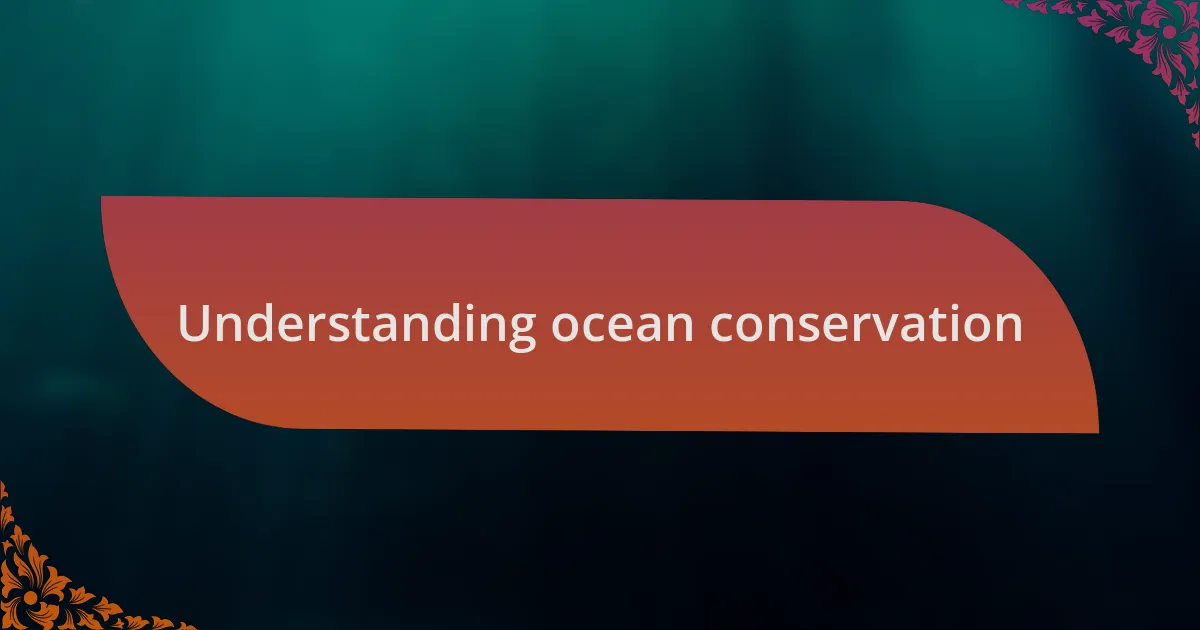
Understanding ocean conservation
Ocean conservation is not just an environmental issue; it’s a deeply personal one for many of us. I remember my first dive, surrounded by vibrant coral reefs teeming with life. The beauty and fragility of that underwater world left a lasting impression on me. How can we ignore the reality that these ecosystems are rapidly deteriorating?
As I learned more about the threats facing our oceans—like pollution and climate change—I felt a tug at my heart. It became clear that the wellbeing of marine life directly impacts human health and livelihoods, too. When you think about it, isn’t our connection to the ocean inseparable from our own existence? These waters are the source of food, economic stability, and even culture for countless communities.
Engaging in ocean conservation isn’t merely an act of protection; it’s a passionate commitment to preserving the heartbeat of our planet. Each time I share my experiences or volunteer for a beach cleanup, I feel a renewed sense of purpose. What small action will you take today to contribute to the conservation of our oceans? The ripple effects of our choices can lead to significant change if we all pitch in.

Importance of documenting marine life
Documenting marine life is crucial because it helps us understand the complex interactions within ocean ecosystems. For instance, I recall a project where we surveyed local fish populations. It was astonishing to see how changes in one species affected others, underlining the delicate balance that sustains marine environments. How can we make informed conservation decisions without this foundational knowledge?
I find that documenting marine animals creates a record of biodiversity that can be critical for future generations. When I visited a marine research facility, I encountered archives of data that showed species migrations over decades. This kind of documentation not only tracks changes but also highlights the consequences of environmental shifts—shouldn’t we pay attention to these warning signs?
Moreover, when we take the time to catalog marine life, we empower communities to engage in conservation. I remember participating in a community-led initiative where local fishermen shared their observations of fish populations. It was a revelation to see how their firsthand knowledge complemented scientific data, fostering a collaborative approach to managing marine resources. Isn’t it empowering to realize that everyone can contribute to protecting our oceans by sharing their unique experiences?
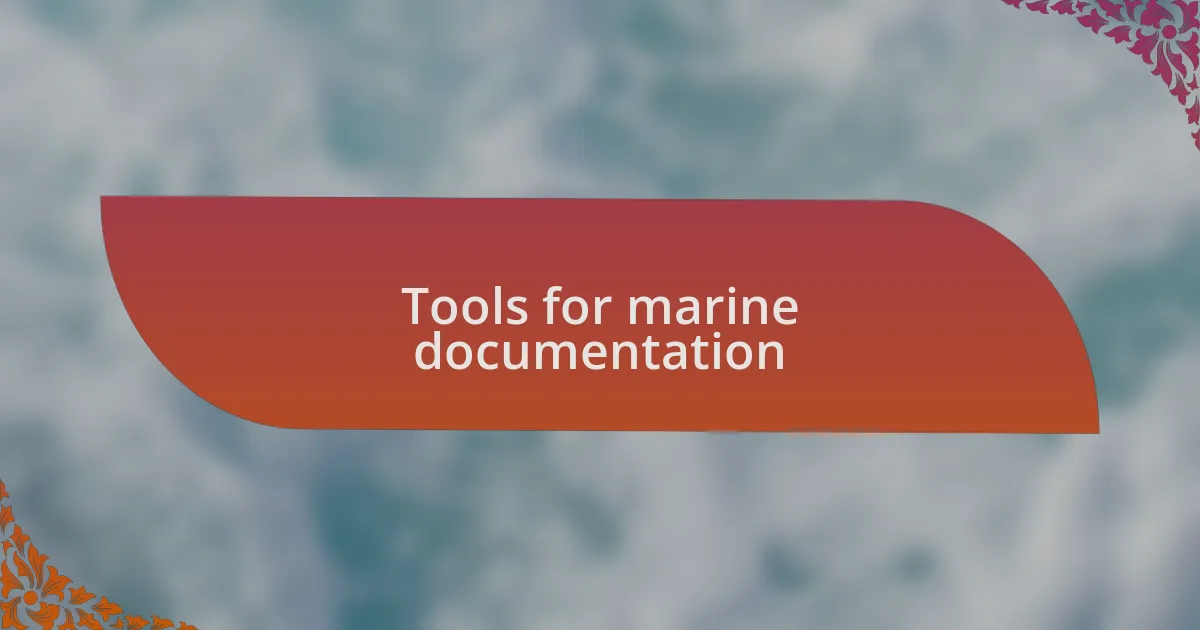
Tools for marine documentation
When it comes to documenting marine life, technology plays a pivotal role. I often rely on underwater cameras and drones to capture realistic images of marine habitats. It’s breathtaking to see how these tools provide a window into the underwater world, revealing behaviors and interactions that are otherwise hidden from our view—don’t you think it’s amazing how technology can bridge that gap?
Field surveys, another invaluable tool, allow researchers like me to collect direct observations and samples from various marine environments. I remember a memorable dive where we used a simple waterproof notebook. Jotting down observations of fish behavior and water quality felt almost primal, a reminder of the art of direct observation. Isn’t there something deeply fulfilling about connecting with nature in such a hands-on way?
Of course, citizen science platforms have transformed the landscape of marine documentation. I’ve participated in initiatives where everyday people contribute to data collection, like recording sightings of endangered species. It’s inspiring to see communities coming together to protect their local ecosystems. What if everyone shared a little piece of their experience? The collective impact could be significant for marine conservation efforts.
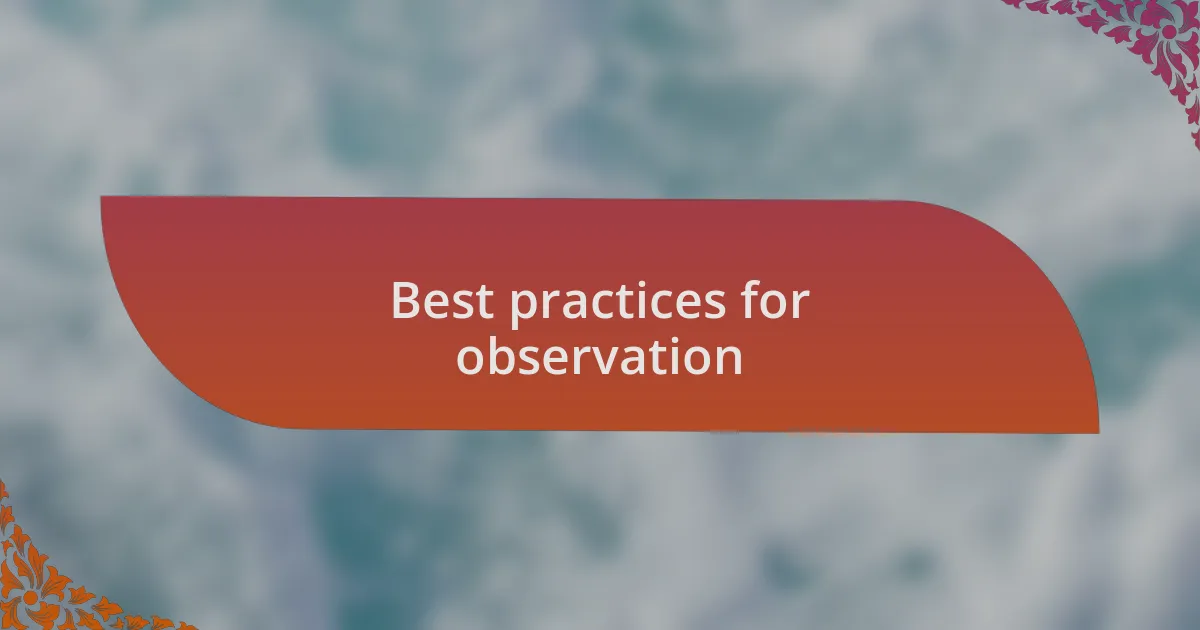
Best practices for observation
When observing marine animals, maintaining a respectful distance is crucial. I’ve often found that getting too close can actually alter an animal’s behavior. There’s this one time I was watching a group of dolphins from a kayak. By keeping a respectful distance, I was able to witness their natural interactions without disrupting them. Have you ever felt that thrill of simply observing without interfering?
Timing is another important factor in effective observation. Early morning or late afternoon often provides the best light and activity levels. I once planned a diving trip around sunrise, and the resulting visibility and vibrant colors made it a magical experience. It’s like watching a live painting unfold right before your eyes. Isn’t it fascinating how the right timing can unveil such beauty beneath the surface?
Lastly, documenting your observations in real time can deepen your connection to the experience. I take my observations seriously, often jotting notes as I go or using an app to record my findings immediately. This not only helps me remember specifics later but also allows me to reflect on the broader ecological context. Don’t you think that when we write down our thoughts, we understand them more deeply?
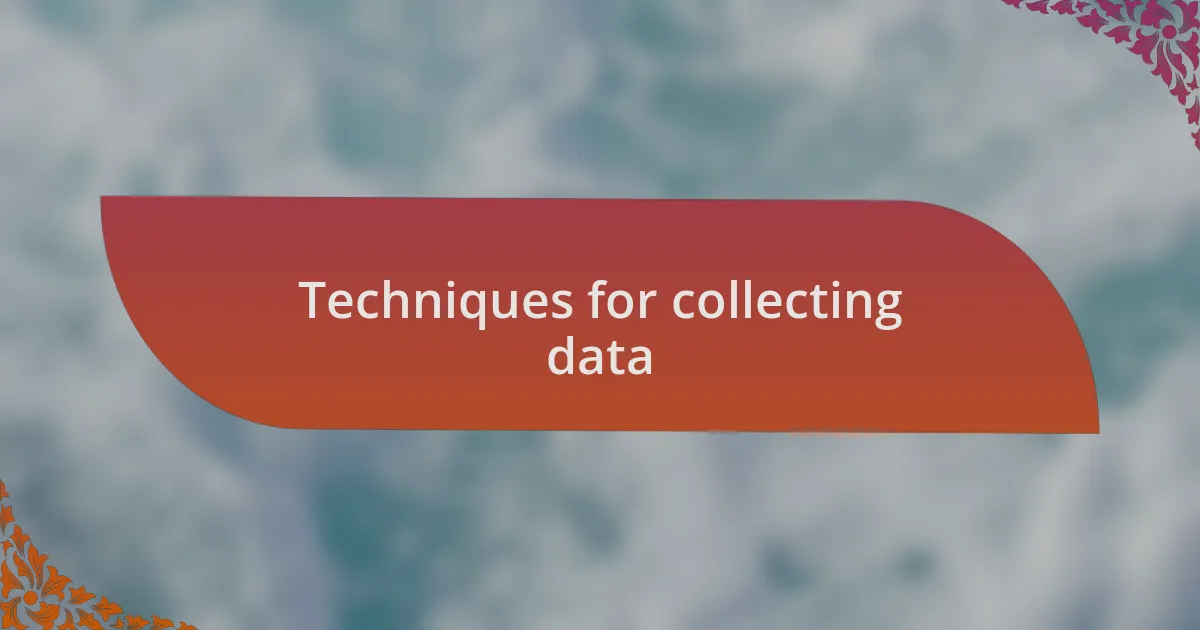
Techniques for collecting data
When collecting data on marine animals, one effective technique I frequently use is deploying underwater cameras. I remember setting up a camera on a coral reef, capturing incredible footage of various species interacting. It was a window into a world I’d never fully experienced before—watching tiny fish dart in and out of crevices, as if they were performing a dance just for me. How often do we take the time to really observe the world beneath the surface, especially when technology allows us to do so from a distance?
Another method I’ve found invaluable is using hydrophones to record underwater sounds. I once spent hours listening to the serenade of whales in a remote area. The haunting melodies resonated through the water and stirred something deep within me. Isn’t it fascinating how sound can provide such insight into the behavior and communication of these magnificent creatures? Capturing these sounds helps researchers understand their social dynamics and migratory patterns, which are vital for conservation efforts.
In addition, I often employ citizen science platforms to involve the community in data collection. I vividly recall leading a beach cleanup where participants documented their findings via a smartphone app, noting species spotted and litter collected. It was empowering to see the collective effort and how easily anyone can contribute to marine research. Have you ever considered that your simple observations could be part of a larger effort to protect our oceans? It truly highlights the shared responsibility we all have in conserving these precious ecosystems.
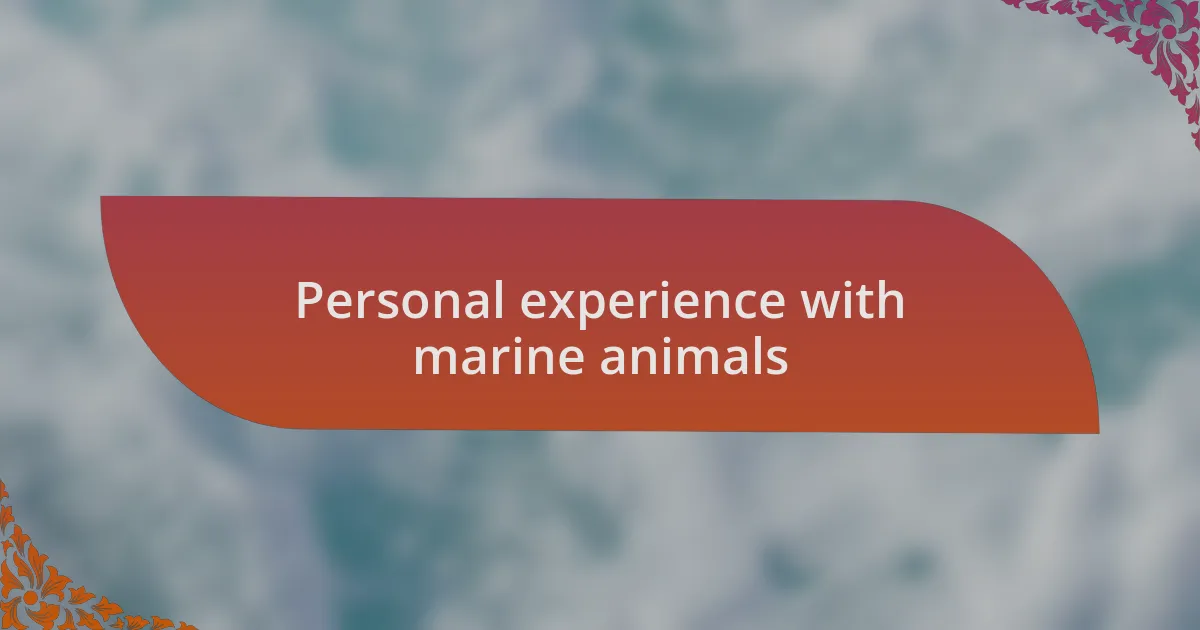
Personal experience with marine animals
My first memorable encounter with marine animals happened during a snorkeling trip in the Caribbean. I can still recall the exhilaration of spotting a sea turtle gracefully gliding through the vibrant coral. It was as if time stood still; my heart raced with both excitement and reverence. Have you ever felt that connection with a creature so different from yourself? That moment sparked my passion for marine conservation.
On another occasion, while volunteering at a marine rehabilitation center, I had the chance to interact with injured seals. Seeing them recover and eventually return to the wild filled me with a sense of purpose. Each interaction taught me about their resilience and the challenges they face in a changing ocean. Isn’t it remarkable how their struggles echo the broader issues our oceans endure? It made me realize that every small act can contribute to their recovery and survival.
I also remember a night dive that was nothing short of magical. As bioluminescent plankton lit up the water, I felt like I had entered another universe. Swimming amidst those glimmering particles, I was reminded of the delicate balance within marine ecosystems. It’s moments like these that challenge us to protect our oceans—how can we not feel compelled to defend such beauty? My experiences have profoundly shaped my perspective on marine life and the urgent need for conservation.
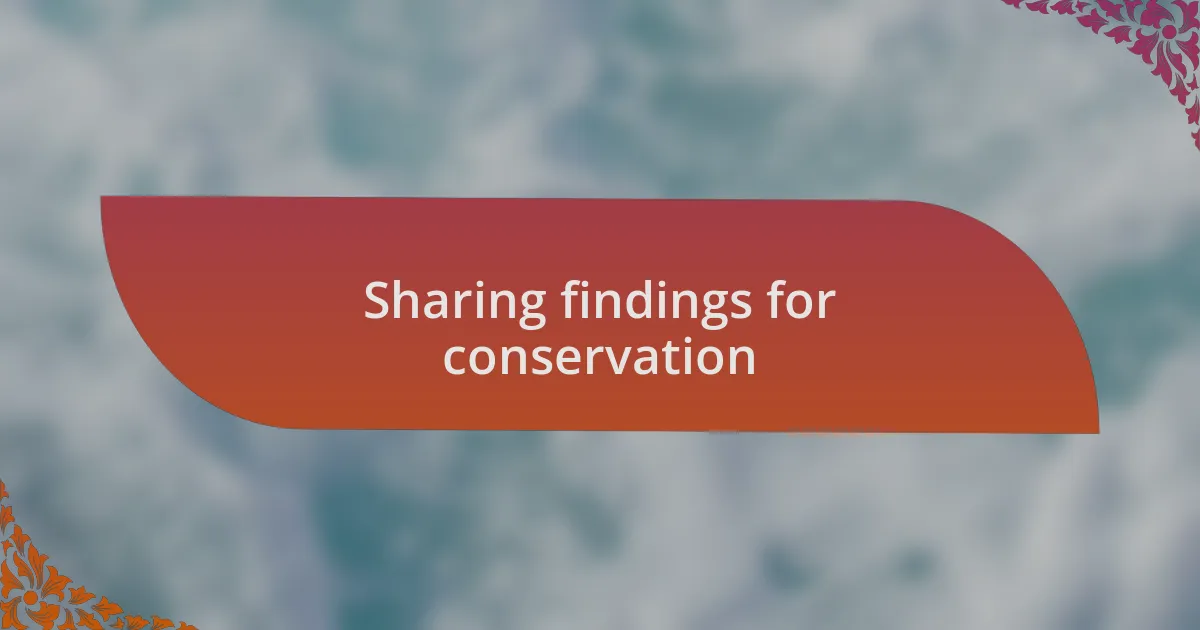
Sharing findings for conservation
Sharing findings is crucial for the advancement of marine conservation efforts. During a community workshop I once attended, conservationists shared their research findings that revealed surprising data about the migratory patterns of dolphins in our local waters. Listening to the passionate discussions that followed, I couldn’t help but wonder how many people were unaware of these majestic creatures’ habits. This exchange sparked inspiration and mobilized community efforts to protect their habitats.
I’ve seen firsthand how sharing discoveries can create tangible change. When I presented my research on plastic pollution in our coastal areas at a local event, the audience’s reactions were profound. Many were shocked to learn how deeply ocean life is affected by debris, which led to a community cleanup initiative. Isn’t it fascinating how knowledge can empower individuals to take action? Witnessing that awakening reinforced the idea that each piece of information shared can build momentum for conservation.
Collaboration often enhances the impact of shared findings. In one instance, I collaborated with a group of marine biologists to create an educational video on the importance of seagrass meadows. The response was overwhelming; people not only viewed the video but also took to social media to discuss it. When insights become accessible to a larger audience, it can spark curiosity and drive greater awareness. How can we leverage our collective knowledge to deepen the fight for ocean preservation? I firmly believe that every shared insight brings us one step closer to ensuring the survival of our precious marine ecosystems.